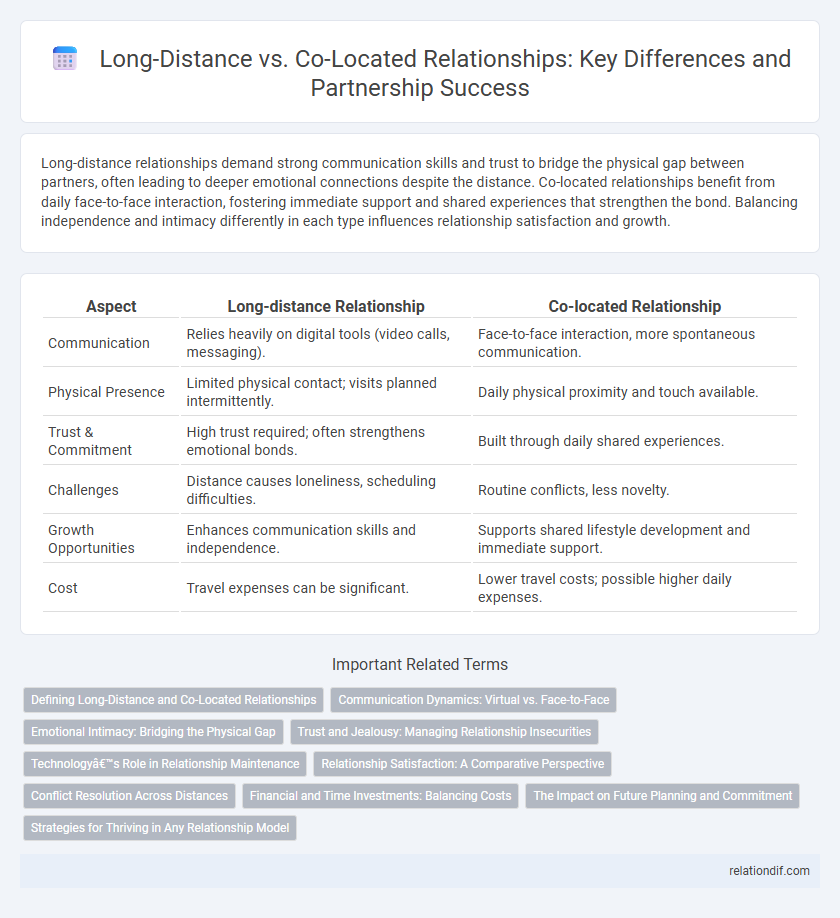Long-distance relationships demand strong communication skills and trust to bridge the physical gap between partners, often leading to deeper emotional connections despite the distance. Co-located relationships benefit from daily face-to-face interaction, fostering immediate support and shared experiences that strengthen the bond. Balancing independence and intimacy differently in each type influences relationship satisfaction and growth.
Table of Comparison
| Aspect | Long-distance Relationship | Co-located Relationship |
|---|---|---|
| Communication | Relies heavily on digital tools (video calls, messaging). | Face-to-face interaction, more spontaneous communication. |
| Physical Presence | Limited physical contact; visits planned intermittently. | Daily physical proximity and touch available. |
| Trust & Commitment | High trust required; often strengthens emotional bonds. | Built through daily shared experiences. |
| Challenges | Distance causes loneliness, scheduling difficulties. | Routine conflicts, less novelty. |
| Growth Opportunities | Enhances communication skills and independence. | Supports shared lifestyle development and immediate support. |
| Cost | Travel expenses can be significant. | Lower travel costs; possible higher daily expenses. |
Defining Long-Distance and Co-Located Relationships
Long-distance relationships are characterized by partners living in separate geographical locations, relying primarily on digital communication methods such as video calls, texts, and social media to maintain emotional connection. In contrast, co-located relationships involve partners sharing the same physical space, allowing for frequent in-person interactions and physical presence. Defining these relationship types centers on the degree of physical proximity, which influences communication dynamics, emotional intimacy, and relationship maintenance strategies.
Communication Dynamics: Virtual vs. Face-to-Face
Long-distance relationships rely heavily on digital communication platforms such as video calls, messaging apps, and email, creating a dynamic where verbal clarity and emotional expressiveness become crucial to maintain intimacy. Co-located relationships benefit from face-to-face interactions that encompass verbal cues, body language, and immediate feedback, fostering a deeper nonverbal connection and spontaneous communication. Effective communication dynamics in both contexts require adapting to unique challenges: virtual interactions demand deliberate effort to build presence, while co-located partners navigate real-time emotional exchanges and physical proximity.
Emotional Intimacy: Bridging the Physical Gap
Emotional intimacy in long-distance relationships depends heavily on effective communication technologies and intentional emotional sharing to bridge the physical gap. Co-located relationships benefit from consistent nonverbal cues and physical presence, which naturally reinforce emotional bonds. Couples in long-distance setups often develop heightened emotional awareness and trust due to reliance on verbal and digital interaction methods.
Trust and Jealousy: Managing Relationship Insecurities
Trust is the cornerstone in both long-distance and co-located relationships, directly influencing how partners manage jealousy and insecurities. In long-distance relationships, consistent communication and transparent sharing of daily experiences help build trust, mitigating feelings of jealousy that arise from physical separation. Co-located couples benefit from frequent face-to-face interactions, enabling immediate reassurance and reducing misunderstandings that could trigger insecurity.
Technology’s Role in Relationship Maintenance
Technology plays a crucial role in maintaining both long-distance and co-located relationships by enabling constant communication and emotional connection. Video calls, instant messaging, and social media platforms bridge physical gaps, fostering intimacy and real-time interaction despite distance. In co-located relationships, technology enhances daily coordination and shared experiences, supporting relationship satisfaction and conflict resolution.
Relationship Satisfaction: A Comparative Perspective
Relationship satisfaction in long-distance relationships often depends on effective communication, trust, and emotional support, with couples reporting high levels of satisfaction when these elements are strong. Co-located relationships benefit from shared daily experiences and physical presence, which contributes to immediate conflict resolution and intimacy, typically enhancing satisfaction. Comparative studies reveal that while co-located couples generally report higher daily satisfaction, long-distance couples can achieve comparable relationship quality through deliberate efforts in maintaining connection and managing expectations.
Conflict Resolution Across Distances
Long-distance relationships often require explicit communication strategies and scheduled check-ins to effectively resolve conflicts, leveraging digital tools to maintain emotional connection despite physical separation. Co-located relationships benefit from immediate, face-to-face conflict resolution, allowing for non-verbal cues and spontaneous problem-solving moments that enhance mutual understanding. Research indicates that long-distance couples who adopt proactive conflict resolution methods report similar or higher satisfaction levels compared to co-located couples, emphasizing the importance of intentional communication in partnership durability across distances.
Financial and Time Investments: Balancing Costs
Long-distance relationships often require higher financial investments due to travel expenses and communication technologies, unlike co-located relationships where costs are shared more naturally through daily proximity. Time investment in long-distance relationships is crucial for maintaining emotional connection despite physical separation, whereas co-located couples invest time in shared activities and spontaneous interactions. Balancing these costs involves strategic planning and prioritizing quality moments to sustain the partnership's health and growth.
The Impact on Future Planning and Commitment
Long-distance relationships often require enhanced communication and trust to maintain commitment, posing unique challenges to future planning compared to co-located relationships. Co-located partners benefit from daily physical presence, facilitating shared activities and more spontaneous decision-making, which strengthens joint future commitments. Research indicates long-distance couples may face delays in achieving long-term milestones, but effective use of technology can mitigate these challenges and support relationship sustainability.
Strategies for Thriving in Any Relationship Model
Effective communication remains the cornerstone for thriving in both long-distance and co-located relationships, with intentional time management and emotional transparency fostering trust and intimacy. Couples in long-distance relationships benefit from scheduled virtual interactions and shared goals, while co-located partners enhance connection through quality in-person experiences and joint activities. Prioritizing mutual support, adaptability, and consistent expressions of appreciation strengthens relationship resilience across any geographic setting.
Long-distance relationship vs Co-located relationship Infographic

 relationdif.com
relationdif.com